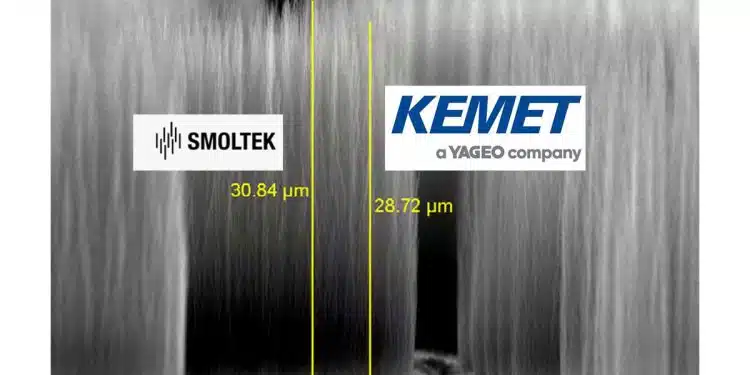Smoltek Nanotech Holding AB announces its intention to enter into a license and services agreement between its subsidiary Smoltek Semi AB (“Smoltek Semi”) and KEMET Electronics Corporation (“KEMET”), a subsidiary of YAGEO Group (“YAGEO”), a global electronic component company, which would grant YAGEO a global, exclusive right to manufacture and sell discrete and embedded capacitor products based on Smoltek’s patented technology platform for ultra-thin carbon nanofiber capacitors (CNF-MIM).
Under the intended terms of the Agreement, Smoltek Semi would receive a royalty on industry market terms based on product sales, and Smoltek Semi would receive fees from KEMET for providing specific technical support services to KEMET for its contribution to the continued joint commercialization of CNF-MIM-based products.
Furthermore, YAGEO is considering an equity-based investment in Smoltek Semi and/or Smoltek. The Agreement will replace the need to set up a JV-entity as previously planned by the parties, enabling YAGEO to more efficiently allocate resources to the collaboration with Smoltek as appropriate, thus facilitating a faster road to market for CNF-MIM based products. The parties intend to finalize the terms and sign the Agreement during the first quarter of 2024.
As previously communicated, Smoltek Semi and YAGEO have entered into a collaboration and initiated product development, as well as industrial process development, for discrete and embedded CNF-MIM capacitors, in accordance with the Memorandum of Understanding signed on [June 29, 2022] (the “MoU”) and the Joint Development Agreement signed on August 17, 2022 (the “JDA”). This includes investment in a custom-ordered carbon nano-growth tool suitable for industrial production in large volumes, which was announced as completed on October 2, 2023.
The next step in the collaboration between the parties, as outlined in the MoU, was to form a jointly owned new Joint Venture Company (“JV-entity”) when a number of predetermined conditions for the performance of the discrete CNF-MIM capacitors were met. The intended purpose of the JV entity was to carry out mass production and sales of discrete CNF-MIM capacitors (“Products”).
During negotiations on the terms of the next step in the collaboration, Smoltek and YAGEO have identified distinct benefits of having YAGEO market and commercialize the Products through its already established organization. This would facilitate a faster and more cost-effective way to bring the Products to market compared to the additional planning and investments needed to form a new JV entity. Furthermore, such an arrangement would allow YAGEO to more efficiently allocate resources to the collaboration with Smoltek as appropriate, including ongoing payment to Smoltek for specific technical work carried out during the continued joint commercialization and industrialization process.
In the light of the above, the parties are now in negotiations to enter into the Agreement, which would grant YAGEO an exclusive global right to manufacture and sell Products, while also allowing for Smoltek to receive payment for specific technical support services. Although the detailed commercial terms of the Agreement are still under negotiation, the parties have agreed on the following structure and outlined terms of the Agreement:
- YAGEO would support development of the Products through payment for services and or potential investments in Smoltek.
- The Agreement shall include a royalty-bearing global exclusive license for YAGEO to commercialize Products.
- The royalty rate shall correspond to industry market terms.
- Smoltek would, on industry market terms, provide services under the Agreement for the development and technical support of the Products.
- YAGEO would potentially make an equity-based investment in Smoltek Semi and/or Smoltek for a minority stake in either company, such terms and structure to be further discussed and negotiated. YAGEO acquiring an equity position in either Smoltek and/or Smoltek Semi is consistent with the intent of the MoU and is in the interest of both parties given the anticipated development effort and associated cost to reach a viable commercial product.
- The Agreement is dependent on successful completion of the JDA with respect to mutual agreement on achievement of JDA metrics and thus commercial viability of the Products.
The parties believe that the adjusted structure of its future collaboration, to be finally agreed upon in the Agreement, will facilitate ongoing negotiations with a joint ambition of the parties to enter into the Agreement during the first quarter of 2024.
“I am proud of the exceptional work carried out by Smoltek and YAGEO during our collaboration up until this point, which has put us in a position where we are eager to double down on our efforts to bring a family of ultra-thin discrete capacitor products based on our CNF-MIM technology to the market. Entering into a license and service agreement with YAGEO makes perfect sense for Smoltek, as it will enable a smooth and rapid transition into the next phase of the collaboration, with each party being able to bring full commitment and resources to the table,” says Håkan Persson, CEO of Smoltek.
“With excellent progress achieved so far in our collaboration with Smoltek Semi, combined with strong interest from potential customers, I am excited that we are planning a future with CNF-MIM technology based discrete and embedded capacitor products produced exclusively by YAGEO. I am certain that such products will become an excellent addition to our product portfolio in the coming years,” says Philip Lessner, Executive Vice President of YAGEO.
The Agreement is expected to have a positive impact on Smoltek’s financial result from the first half of 2024, initially due to payments from YAGEO for services provided by Smoltek Semi related to the continued commercialization of the Products.































